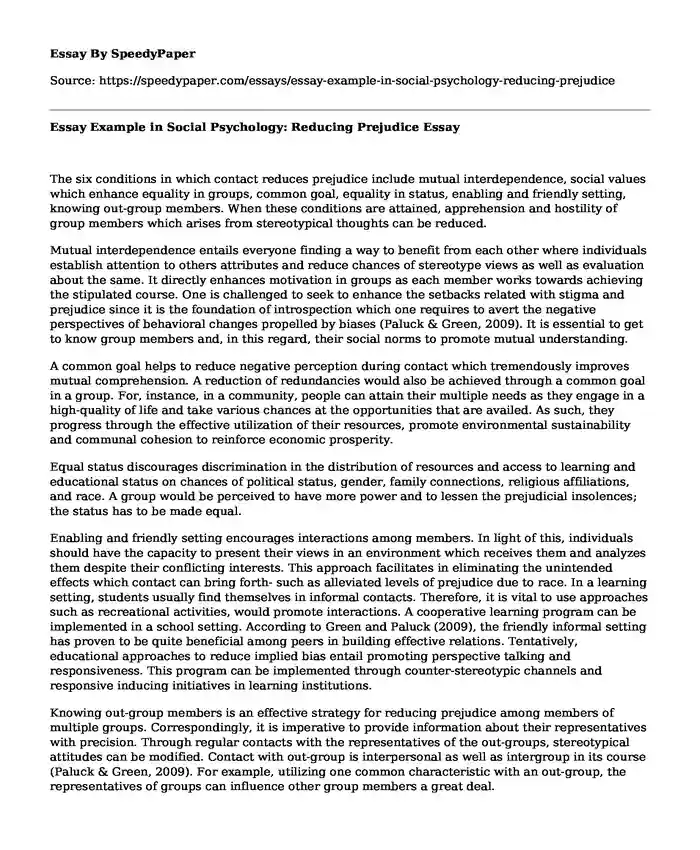
| Type of paper: | Essay |
| Categories: | Social psychology |
| Pages: | 3 |
| Wordcount: | 627 words |
The six conditions in which contact reduces prejudice include mutual interdependence, social values which enhance equality in groups, common goal, equality in status, enabling and friendly setting, knowing out-group members. When these conditions are attained, apprehension and hostility of group members which arises from stereotypical thoughts can be reduced.
Mutual interdependence entails everyone finding a way to benefit from each other where individuals establish attention to others attributes and reduce chances of stereotype views as well as evaluation about the same. It directly enhances motivation in groups as each member works towards achieving the stipulated course. One is challenged to seek to enhance the setbacks related with stigma and prejudice since it is the foundation of introspection which one requires to avert the negative perspectives of behavioral changes propelled by biases (Paluck & Green, 2009). It is essential to get to know group members and, in this regard, their social norms to promote mutual understanding.
A common goal helps to reduce negative perception during contact which tremendously improves mutual comprehension. A reduction of redundancies would also be achieved through a common goal in a group. For, instance, in a community, people can attain their multiple needs as they engage in a high-quality of life and take various chances at the opportunities that are availed. As such, they progress through the effective utilization of their resources, promote environmental sustainability and communal cohesion to reinforce economic prosperity.
Equal status discourages discrimination in the distribution of resources and access to learning and educational status on chances of political status, gender, family connections, religious affiliations, and race. A group would be perceived to have more power and to lessen the prejudicial insolences; the status has to be made equal.
Enabling and friendly setting encourages interactions among members. In light of this, individuals should have the capacity to present their views in an environment which receives them and analyzes them despite their conflicting interests. This approach facilitates in eliminating the unintended effects which contact can bring forth- such as alleviated levels of prejudice due to race. In a learning setting, students usually find themselves in informal contacts. Therefore, it is vital to use approaches such as recreational activities, would promote interactions. A cooperative learning program can be implemented in a school setting. According to Green and Paluck (2009), the friendly informal setting has proven to be quite beneficial among peers in building effective relations. Tentatively, educational approaches to reduce implied bias entail promoting perspective talking and responsiveness. This program can be implemented through counter-stereotypic channels and responsive inducing initiatives in learning institutions.
Knowing out-group members is an effective strategy for reducing prejudice among members of multiple groups. Correspondingly, it is imperative to provide information about their representatives with precision. Through regular contacts with the representatives of the out-groups, stereotypical attitudes can be modified. Contact with out-group is interpersonal as well as intergroup in its course (Paluck & Green, 2009). For example, utilizing one common characteristic with an out-group, the representatives of groups can influence other group members a great deal.
Social values which enhance equality in groups help reduce prejudice if the intergroup contact is conducted in a free and equal manner (Aronson, Wilson & Akert, 2013). The sure way to change the false norms is to re-evaluate them which should be done with the aim of making alternative approaches of individuals social relations. Through the evaluation, a group can obtain norms to create new viewpoints and behavioral changes coupled with self-actualization with one's presumptions and those believed by others.
References
Aronson, E., Wilson, T. D., & Akert, R. M. (2013). Social psychology (8th ed.). Upper Saddle River, NJ: Pearson.
Paluck, E., & Green, D. (2009). Prejudice reduction: What works? A review and assessment of research and practice. Annual Review of Psychology, 60(1), 339-355. doi:10.1146/annurev.psych.60.110707.163607
Cite this page
Essay Example in Social Psychology: Reducing Prejudice. (2022, Jun 17). Retrieved from https://speedypaper.com/essays/essay-example-in-social-psychology-reducing-prejudice
Request Removal
If you are the original author of this essay and no longer wish to have it published on the SpeedyPaper website, please click below to request its removal:
- Essay Example on Contributions to Defined Contribution Pension Plans
- Free Essay on Personality Disorder - Case Analysis of Sally
- Essay Sample: Ethical Concerns in Jane Elliot's Experiment
- Free Essay Sample on Social Media and Phonelessness Experience
- Free Essay Sample with Opinion on Abortion
- Essay Example Dedicated to Dr. John Cade and His Discovery
- Free Essay on Symptoms, Diagnosis, and Treatment of Pseudotumor Cerebral
Popular categories




